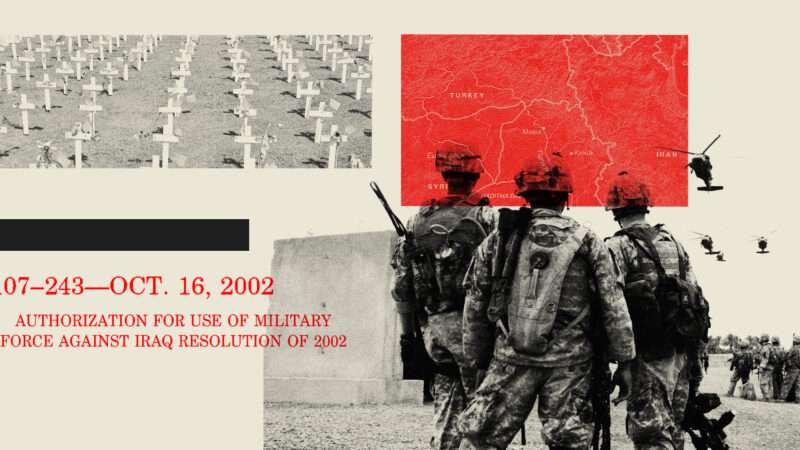
Two decades ago, the war in Iraq began. The regime change mission was “accomplished” in a matter of weeks. Then, after that initial steroid high wore off, the limits of American military might started to show.
The U.S. occupation produced one tragic debacle after another. Public judgment of the war’s proponents moved from “convincing” to “mistaken” to “deceptive” to “deplorable.” Hundreds of thousands of Iraqis died, and millions more endured needless suffering. Baghdad did not emerge as a shining city on a hill. Once enthusiastic about the invasion, the American people first stopped delighting in the project and then, unless forced to attention by some discrete new horror like the rise of the Islamic State (IS) group, stopped looking at all.
When did the war in Iraq end? Or are we right to speak of it entirely in the past tense? This ought to be easy to answer, on the 20th anniversary of the invasion no less, but the situation is nebulous at best. It makes the questions worth asking, and it poses a real—if difficult to measure and easily ignored—risk to American security, too.
Fixing an end date for this war is messy in part because we have so many options on hand. Former President George W. Bush said “major combat operations” were done in May 2003, but that didn’t exactly hold up.
By a slightly more plausible account, the war’s been over for a dozen years. Then-President Barack Obama announced he was “responsibly ending the war in Iraq” in 2009, shortly after he came to office, in part on the strength of his condemnation of Bush’s decision to invade. The combat mission officially concluded for a second time two years later, in 2011, with around 700 U.S. troops remaining behind in an advise-and-assist role, along with several thousand U.S. contractors.
But once IS started grabbing land in Iraq and neighboring Syria in 2014, committing anachronistic atrocities along the way, the Obama administration went back in. This second round never included a U.S. ground presence anywhere near the scale of the 160,000 American soldiers (plus nearly as many contractors) deployed during the 2007 surge. But U.S. forces again numbered in the thousands and continued to do so until the Iraqi government in 2020 asked then-President Donald Trump to make another exit plan.
The Trump administration dismissed that request, so it wasn’t until the end of 2021 that President Joe Biden announced the third end of the U.S. combat mission in Iraq. This time, about 2,500 U.S. soldiers stayed behind to advise and assist—indefinitely.
This month, Defense Secretary Lloyd Austin made a visit to Baghdad to discuss those 2,500. “We focus on the mission, which is the defeat of ISIS, and we are here not for any other purpose,” he said, reiterating the Biden administration’s position (which some Iraqi parliamentarians contend is a lie) that these troops won’t do any actual fighting. But Austin also said “any attacks against our forces could undermine that mission,” alluding to dozens of attacks on U.S. bases in Iraq and Syria by Iran-linked militias. Those attacks have slowed but do still happen, at least as recently as January.
The Iran connection is important here because IS is transparently not the only reason for the ongoing U.S. military presence in Iraq, whatever Austin claims. In 2019, Trump revealed he wanted to stay in Iraq long-term to “be able to watch Iran.” “This is what a lot of people don’t understand,” he said. “We’re going to keep watching, and we’re going to keep seeing, and if there’s trouble—if somebody is looking to do nuclear weapons or other things—we’re going to know it before they do.”
Biden hasn’t been as unreserved as Trump in his comments on the strategy here, but countering Iran is widely understood to be a U.S. objective in keeping a toe in Iraq. Austin’s trip was also meant as a show of support for the Iraqi prime minister’s “push back against Iranian influence in the country, former officials and experts” told Reuters, with an unnamed senior U.S. defense official adding that “Iraqi leaders share our interest in Iraq not becoming a playground for conflict between the United States and Iran.”
Avoiding a third round of the war in Iraq, with Iran taking the place IS and Saddam Hussein held in prior iterations, is indeed in both U.S. and Iraqi interests. But it’s far from clear that this indefinite American force presence is a good way to achieve that goal.
Keeping thousands of U.S. soldiers in rocket range of Iran-linked militias props open a door to the very reescalation we want to avoid. There’s no vital U.S. interest served by this indefinite advise-and-assist mission—our national security would not be materially affected if it ended tomorrow—but it does give these militias, the last bits of IS, and any other regional actors who want to have a go at America a convenient local target for their wrath and a perpetual billboard for recruitment.
The extent of that risk is difficult to gauge, and, hopefully, the potential reescalation will never happen. But this time a decade ago we were a year and a quarter out from the “end” of the war in Iraq, with a residual advise-and-assist force in place—and a year and a quarter away from the war’s rebeginning. And now we’re a year and a quarter out from another end of the war in Iraq, with a residual advise-and-assist force in place. It’s not unreasonable to ask: Is it over?
The post Two Decades Later, the War in Iraq Is Over—Right? appeared first on Reason.com.
from Latest https://ift.tt/PFqzViS
via IFTTT